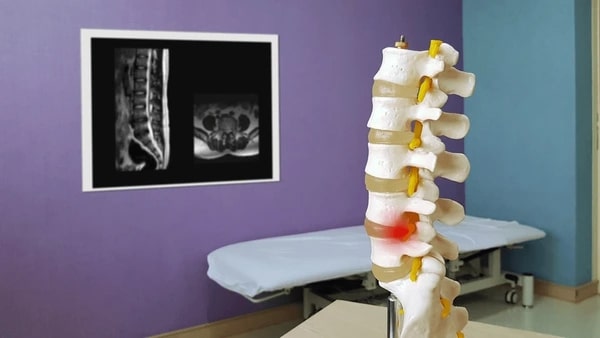Back pain is one of the common conditions associated with people as they age. It can also lead to disability, and eventually prevent patients from following an active lifestyle. Early diagnosis and management of back pain are crucial elements for successful treatment. If you live in Chennai and experience severe back pain related to old age, consult Dr. Vignesh Pushparaj today. He is one of the leading, trusted and best back and neck pain doctors in Chennai.
How Does Age Affect Back Pain?
A majority of men and women experience low back pain during their lifetime and it is caused by various non-specific and self-limiting factors. The possibility of experiencing chronic back pain increases as one grows older due to physical and psychological changes that occur. When compared to adults who are working, older adults are likely to be affected by the following:
Low Back Pain Pathologies such as Spine Tumours, Spinal Infection, Lumbar Spinal Stenosis, Osteoporotic Vertebral Fractures
Physical and psychological changes that occur with age like Spinal Degeneration, Comorbidities, Inactivity and Changes in Pain Processing Mechanism
Risk Factors based on Genetics, Gender and Ethnicity
This is the reason why lower back pain in 50-year-old woman/man & above is common than in the young population. So, what exactly happens to the spine with ageing? Find out in the next section.
How Ageing Affects Your Cervical Spine?
The cervical spine is a crucial part of the body because it supports the weight of the head and assists mobility. In addition, electrical signals are passed on from the brain to other parts of the body via the spine. Due to the complex structure of the spine comprising seven vertebrae (C1-C7), six intervertebral discs, muscles, tendons, ligaments and nerves, any damage can affect the neck, shoulders, arm, and upper back of the body.
Ageing can affect the cervical spine in the human body. The wear and tear of the spine over many years leads to the degeneration of various moving parts such as discs, facets and joints.
Causes of Low Back Pain in Older Adults
Mechanical or Non-specific Low Back Pain
The recent studies have shown that majority of older adults with low back pain do not have a definite pathology such as degeneration or inflammation. This is similar to back pain among young adults who are diagnosed with non-specific low back pain. This type of pain may result from different factors depending on the time of the day, specific physical activity and posture.
In addition, non-specific low back pain may originate from different sources such as disc degeneration, facet joint pain, lumbar degenerative spondylolisthesis, facet hypertrophy etc. It may also originate from structures besides lumbar spine. Older patients with chronic back pain resemble that of sacroiliac joint pain and myofascial pain. Due to multiple factors, it is often difficult to ascertain the sources of non-specific low back pain.
Radiculopathy
Nerve root compression or spinal meninges due to degenerated spinal structure may cause Radiculopathy that radiates distal to the knee. Lumbar Spinal Stenosis (LSS) may also lead to bilateral radiculopathy sometimes with low back pain. Research has shown that degenerative LSS possibility increases with age.
Osteoporotic Vertebral Fractures
Women often experience Osteoporotic Vertebral Fractures and associated low back pain because of the hormonal changes post menopause. Again, the prevalence of this condition increases with age. Approximately 40% of women above 60 years of age suffer from this condition. It is unfortunate that older adults often disregard diagnosis and treatment as they assume it is only bone and joint pain related to aging.
De Novo Degenerative Lumbar Scoliosis, according to doctors, is a deformity of the spine that causes disabling low back pain in older adults. It is known to affect people after 50 years of age and its prevalence among people over 60 years is as high as 68%. Intervertebral disc degeneration and genetic predisposition are few major causes.
Spinal Infection
Vertebral Osteomyelitis (VO) is an infection of vertebral bones that affects older people. Considered as a life-threatening disease, different causes of VO includes pathogenic bacteria, tuberculous infection at a young age, aerobic gram-negative bacilli with urinary infection and iatrogenic infection from spinal surgeries or injections.
Visceral Diseases
Older adults usually may have co-morbidities which may cause chronic low back pain beside spinal pathologies. Many visceral diseases such as nephrolithiasis, cholecystolithiasis, prostatitis, urinary tract infection, pelvic inflammatory disease and others show symptoms similar to low back pain.
Several modifiable and non-modifiable risk factors are associated with the development of severe or chronic low back pain in older adults. You can find comprehensive information on back pain in our blogs section. Stay tuned for updates!
How to Keep Back Healthy?
Age is the driving factor that causes back pain. However, there are additional reasons that can contribute to back pain. These factors need to be managed properly. Here are a few ways to keep back healthy:
- Maintaining proper body weight
- A balanced and nutritious diet.
- Limiting vigorous, dangerous and high-impact physical activities.
- Avoid smoking.
- Maintaining and practising good posture.
- Proper sleep habits
Avoiding stress.
How to Cure Back Pain in Old Age?
First of all, a thorough investigation is done by doctors to better understand low back pain in older adults. It will include medical history of the patient, pain characteristics and features, disability due to pain, and physical examination. In addition, special care is taken to optimize pain management process in older adults.
After the doctor has ascertained the cause of back pain, a treatment plan will be suggested. It can include various non-surgical pain treatment options such as limiting the movement of the back using braces, physical therapy sessions aimed at reducing muscle spasms and medications to provide relief from pain.
Surgical treatment is recommended when the traditional form of treatment doesn’t work. Also, it is often suggested in case of definite diagnosis of lumbar pathology in older people. Decompression surgery such as laminectomy, laminotomy and discectomy are used to eliminate lumbar structures that put pressure on neural nerves. Recent studies further indicate that minimally invasive spine surgeries are more successful than open lumbar decompression surgery.
Always consult the doctor before making the final decision regarding surgery.
Back & Neck Pain Specialist in Chennai
Dr. Vignesh Pushparaj is one of the leading, trusted and experienced spine specialists in Chennai who has successfully treated countless patients with complex spinal disorders and related conditions. For more details about the treatment approach, surgical experience and appointments, contact us at any time.






0 Comments